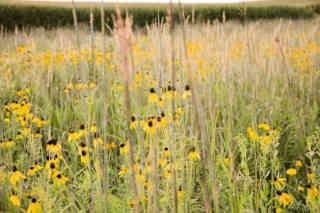By Ann Staudt
A publication that provides farmers and landowners with practical advice regarding the process of creating perennial vegetation areas that aid in soil health and water quality improvement has been recognized nationally by the American Society of Agronomy.
The publication and the Conservation Learning Group that helped produce it earned first place for short publications in the Educational and Outreach Materials Awards.
What to Expect: Establishing Prairie Vegetation on Your Farm, was produced by Iowa State University Extension and Outreach and the Conservation Learning Group at Iowa State, and is available on the Iowa State Extension Store.

“We are honored to have our work recognized by ASA,” said Mark Licht, associate professor and extension cropping systems specialist at Iowa State University. “We are eager to share this publication with colleagues and to help decision makers move forward from consideration to action on their lands. Our goal with this guide is to provide a clear and concise overview that sets expectations for years one through seven in a typical conversion to prairie plantings. The guide also encourages consultation with one of the many experts who understand the process and timeline for prairie establishment.”
Perennial plantings, including in-field strips, edge-of-field plantings and conversion of marginal or unprofitable areas within row crop fields to prairie, have proven to provide tremendous benefits to land and water quality.
This guide highlights the short-term benefits of perennial plantings such as improved runoff management, water infiltration and potential improvements in overall field profitability. Mid and longer-term advantages mentioned are establishment of wildlife habitat, forage and even hay resources.
“CLG has also recently updated the Whole Farm Conservation Best Practices Manual, a complementary resource to this guide, which provides landowners and conservation professionals with assessment and decision tools to help determine which practices will work best on a particular area of land,” continued Licht. “The first edition of this manual received recognition from ASA in 2021 and now includes additional sections on multipurpose oxbows, windbreaks, riparian forest buffers and bottomland timber establishment. We are delighted to continue to offer free-of-charge resources such as the What to Expect guide and whole farm manual to users across the country.”
The guide was produced in collaboration with Iowa Learning Farms, North Central Sustainable Agriculture Research and Education, Consortium for Cultivating Human and Naturally reGenerative Enterprises and Science-based Trials of Rowcrops Integrated with Prairie Strips, including information from the Tallgrass Prairie Center.
Authors of What to Expect: Establishing Prairie Vegetation on Your Farm are extension specialists Mark Licht, Jacqueline Comito, Adam Janke, Liz Ripley, Ann Staudt and Nathan Stevenson.
To learn more about Conservation Learning Group, visit www.ConservationLearningGroup.org.
Source : iastate.edu